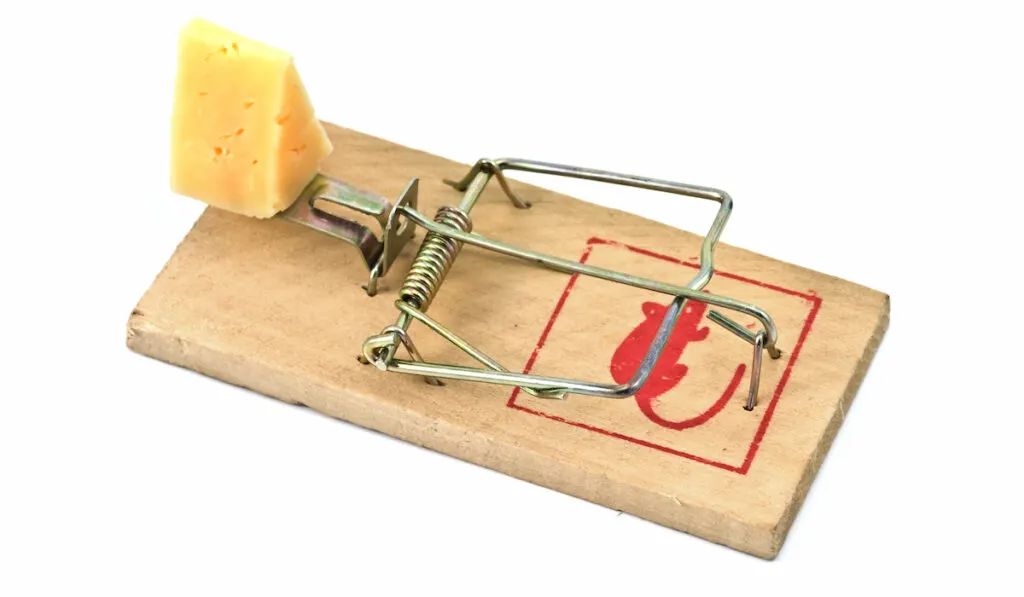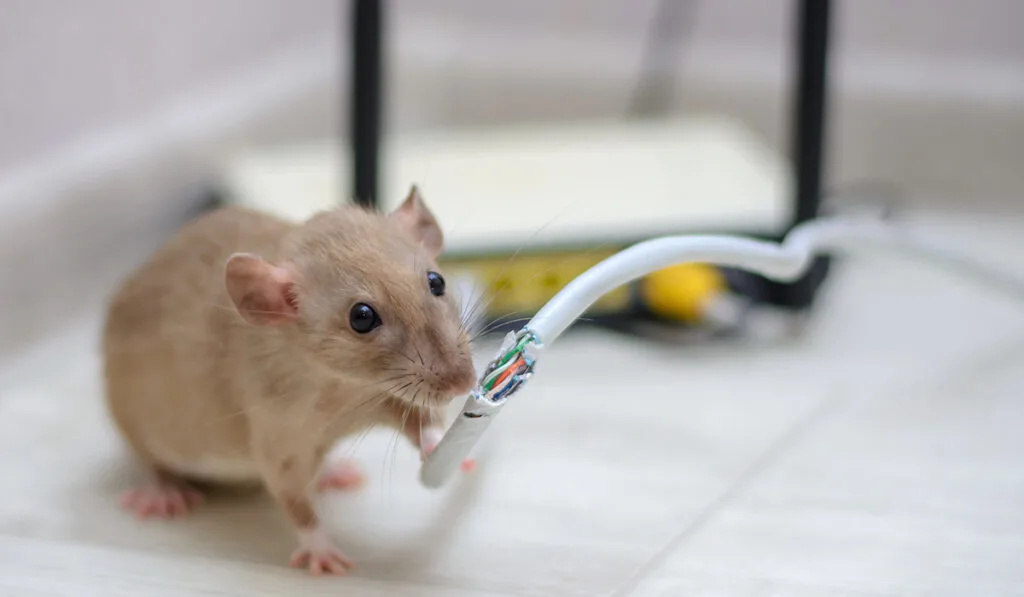*This post may have affiliate links, which means I may receive commissions if you choose to purchase through links I provide (at no extra cost to you). As an Amazon Associate, I earn from qualifying purchases. Please read my disclaimer for additional details.
That feeling of anger when you pull a box of decorations out of the garage, only to find everything covered with teeth marks. It’s even worse when it’s also covered in mouse droppings. Once you discover there are mice in your garage, you better move quickly before it becomes an out of control situation.

How do you get rid of mice in the garage? If you have reason to believe you have mice in your garage, using a trap of some sort is a good way to evict them. Using simple snap traps is an easy and inexpensive way to dispose of mice. There are catch and release traps where you can capture mice and then release them, alive, somewhere far from your home. If you find a heavy infestation, professional help may be needed to rid the garage of your rodent pests.
There are many options on the market today for you to consider when getting rid of your garage mice. You may have to use a combination of traps and procedures to totally rid the space of pests. Below are different ways to evict these unwanted guests.
Table of Contents
5 Best Ways Getting Rid of The Mice in Your Garage
It is a good idea to protect your hands while handling traps or baits. You don’t want to leave anything behind, like body oils, that the mice can smell. If you do, they will not approach the trap you have set for them. Below is a list of traps available:
- Snap traps
- Sticky traps
- Catch and release traps
- Poison traps
- Professional Exterminators
1. Snap Traps

Snap traps tend to be the standard when it comes to getting rid of mice. They do offer a few different options now besides the small wooden bar trap you often see used.
There is a clam snap trap with a spring-loaded jaw, rather than a bar, that comes down on the mouse. Where the bar trap is supposed to be a lethal blow the clam snap trap is supposed to suffocate the mouse.
Snap traps require a little more maintenance than other traps. They can be messy and dangerous if you do not keep track of where they are. They are recommended for small infestations due to how many traps you may want to set.
A pro for these traps is price. They tend to be more cost effective, giving consumers the option to purchase more and not feel guilty throwing away the trap once it has caught a mouse. This makes dealing with the catch a little easier.
Stores offer a hidden snap trap where you don’t have to see the catch. It works like a bar trap except everything happens inside a container where you cannot see the mess.
2. Sticky Traps
Sticky traps or glue traps are another form of trap that is easy to dispose of once a mouse has been caught. Animal rights groups consider this method inhumane (peta2.com).
The way it works is the mouse gets stuck to the trap when it comes in to investigate the bait. It then cannot free itself and death comes when it cannot get away for food or water.
Other animals can get caught in the trap and they don’t immediately die. When anything is caught on this type of trap it could take hours or days for them to pass away.
If this is something that concerns you, it might be a good idea to look into different methods of evicting your uninvited guests.
3. Catch and Release Traps
You may choose to catch mice and set them free in a better place, generally far away from your property. You should probably travel at least three miles from your home to prevent the mouse from coming back (source).
This type of trap usually involves a box with an automatic door that shuts once the mouse comes in and trips the sensor. This is a good option to go with if using a messy trap bothers you, but it takes a little bit of time to catch a mouse.
One of the biggest tips when using these catch and release traps is to check them often. The mouse could starve if left too long. Keep track of where you’ve placed them and check them often; at least daily.
4. Poison Traps
This option is a little tricky. You must be careful laying these traps because other animals or small children could get a hold of these.
If you choose this method or believe it is your best option, check for tamper resistant traps and place them in locations where other pets or children don’t have access to them. This can be an effective option if done correctly.
5. Professional Exterminators
If your garage infestation is extremely bad, it’s possible putting traps out will not help contain the problem. There are professional services that can come and help de-mice your garage.
A professional exterminator can inspect the area and decide on the best and most effective method to not only rid your building of mice but keep them away from future infestations.
What kind of Bait Should You Use?
There’s a little debate on what is the best bait to catch a mouse. Here is a list of the most common used:
- Peanut butter
- Sticky candy
- Chocolate candy
- Cheese
- Some meat like hotdogs or beef jerky
Choosing the bait may depend on what type of trap you use. A snap trap tends to have a sensitive trigger better suited for a lighter bait. Finding a food with a strong smell may work better since mice are known to have a keen sense of smell.
Signs There Are Mice in the Garage

Not sure if there are mice in the garage? There are a few things to look for when you’re suspicious they have moved in:
- Trails of mouse droppings
- Blankets or loose clothes have holes in them
- Bits of food around the floor
- Odd noises at night
You may not actually see the mice at first, just evidence they’ve been there. Mice are nocturnal creatures who do most of their moving around in the night-time. Mice do not like bright lights and will generally be living in closets or cabinets where there’s little human activity.
1. Trails of Mouse Droppings
Mice can produce up to 100 droppings per day per mouse. Observing how much mouse dirt you are finding can be an indicator of how many mice you currently have in your space.
It’s important to handle mouse droppings carefully when cleaning up. It can carry disease and bacteria that is sometimes harmful to humans. Some mice carry Hantavirus.
As explained by MedlinePlus, the Hantavirus spreads to humans when they breathe in dust from dried mice feces or from the nest shavings.
2. Blankets or Loose Clothes Have Holes in Them
Depending on what you store in your garage mice can do damage:
- Do you keep extra food there?
- Are you storing blankets or winter clothes?
- Do you keep garbage there until trash day?
If you use the garage as an extra storage space for valuable goods, be sure to protect them with things mice cannot wiggle into or chew through. Any weakness in your storage option could mean damage to irreplaceable items or a huge mess for you to clean up.
Mice must find material to chew up and gather for their nests. If you do not have things properly stored, then there is a possibility a mouse will find them and make bedding out of them.
Once a mouse has found some bedding material, they will pick a location to hunker down in. Look in empty bags or boxes that are not normally used. Be careful picking up the bundle because there could be baby mice in them.
3. Bits of Food Around the Floor
Mice are considered omnivores which means they eat plants, nuts and meat. They tend to eat around 20 times a day. They will try to eat anything not properly sealed or put away.
Mice don’t need much water and tend to get what they do need from their food. If they do drink straight from a water source it tends to be very little.
If you happen to store nonperishables, such as cereals or grains, be sure to put them in plastic or metal containers because mice can chew through boxes and bags. They will gather the food and store it near their nest. They also enjoy getting into your pet food if you have it nearby.
4. Odd Noises at Night
Late in the evening or night, you might hear what sounds like pecking or scraping. This could be a sign you have mice in the walls or ceiling of your garage. This can be frustrating because it makes it harder to capture and dispose of the rodent, but it could also be hazardous.
When a mouse has nested inside the walls, they sometimes collect insulation for their nests. While they are chewing up this material, they sometimes chew electrical wires along the way. This could cause a short and in extreme cases a fire.
It is believed rodents cause around 20% of undetermined fires in the United States each year. (source)
How to Prevent an Infestation
Once you decide on a route to rid yourself of the mice inhabiting your garage the next step is to prevent it from happening again.
A garage could have several weak points that let mice in and make them want to stay. Reducing entry points and resources the mice need, may keep them away.
Finding and Sealing Entrance Points
A mouse can slip through holes that are anywhere from a quarter inch to half an inch small. They like to hide in places that are dark and out of reach to humans or predators. There are several places to watch for rodent entry:
- Holes in structure
- Gaps around any plumbing
- Big gaps under exterior doors
- Big gap under garage door
- Open windows
Patching any obvious holes in the structure is a good start. You could replace the drywall with patches and drywall mud. Homeowners could use caulking around edges where they suspect mice have gotten in.
A common trick some people try is putting steel wool into the holes. There are a few different ways to do this. This video gives a demonstration of one method you could use with steel wool and caulking. The video goes on to describe a device used to fill in holes for brick exterior walls which could apply to you.
You could also just place the steel wool into the holes you suspect mice are coming in through. The problem with this method is the wool may fall out.
Be sure there are no gaps around pipes or wires going in and out of your building because these are great paths for mice.
While looking for visible gaps, be sure to check out any exterior doors for proper installation because a mouse can fit through cracks or small openings located around these doors.
Doors are great ways for mice to gain entrance because some have openings at their bottom. Installing some form of weather stripping is a good way to stop them from entering.
Check to see if the stripping on the bottom of your garage door needs to be replaced and take the steps to do so if needed. If this step seems complicated, see if a professional can do this task.
Make a habit of shutting all windows and doors tightly when the garage is not in use. Mice will look for shelter and food when the weather turns cold. And an open door is an opportunity.
It’s a good idea to move piles of wood or debris away from the building because these are good areas for rodents to hide or inhabit.
Knowing Whether You Have Rats or Mice
It might not seem like there are many differences between rats and mice. Many people confuse the two.
When it comes to getting rid of rodents it is important to know if you have mice or rats living in your garage. The way they eat, breed and behave can help you figure out an effective trap system.
Some of the differences between mice and rats are:
- Size
- Life expectancy
- Gestation
- Droppings
- Behavior
Common Traits of Mice
A mouse tends to be smaller in size compared to a rat. Mice are usually under seven inches long including their tales. When it comes to life expectancy, they live around a year if in the wild. If they manage to stay indoors with good shelter and food, they may live for close to three years.
According to an article on livescience.com, a female mouse can have anywhere from four to 12 babies and they generally have litters every three weeks. A small problem can turn into a big one quickly if action is not taken immediately.
A mouse will check out traps and sniff out the bait. This is what makes them easier to catch compared to the rat.
Common Traits of Rats
Rats are larger in size. They can weigh close to 11 ounces compared to the half-ounce of a mouse. Rats can live for 2-3 years in the wild and around four years if kept as a pet.
The behavior of the rat might be what keeps it living longer than the mouse. Where a mouse is curious and tends to go out on more adventures, a rat is cautious. The rat is fearful and will stay hidden longer making it harder to catch them.
What if You Have a Rat in Your Garage?

If you do discover rats in the garage instead of mice then you will need to consider your trapping method. A few things to consider:
- Size of trap
- Kind of bait
- Location of trap
Because rats are larger than mice, you will need a larger trap. Remember that rats tend to be more cautious than mice and it could be harder to attract them to a trap.
Bait will depend on what the rat is most attracted to. There are breeds of rats who prefer peanut butter or grains. Then there are those who will be tempted by that stereotypical stinky cheese. You might have to experiment with different lures.
The location of the trap could be the most important thing to remember when going after these larger pests. Rats tend to follow familiar paths and keep routines when traveling place to place. Setting traps along the garage walls, outside and inside, will increase the likelihood of catching them.
You may have to do a couple options together depending on the infestation. Whether you are killing the rodents or setting them free, with them gone, additional resources are now available to the pests that are left. This means without preventative habits; remaining mice could continue to reproduce and continue to inhabit your garage.
